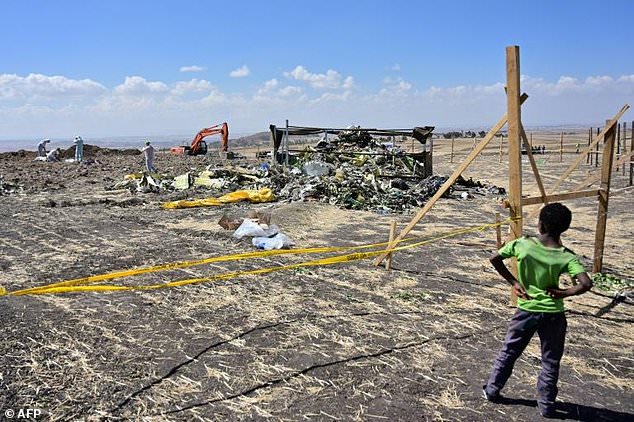
The two planes’ flight recorders provided the strongest indication yet that an anti-stall system malfunctioned in both the Ethiopian Airlines crash of March 10, 2019 — the aftermath of which is seen here — and Lion Air’s 2018 crash in Indonesia
Boeing’s MCAS anti-stall system, which was implicated in the October crash of a 737 MAX 8 airliner in Indonesia, was also activated shortly before a recent accident in Ethiopia, a source with knowledge of the investigation said Friday.
The information is among the preliminary findings from the analysis of the “black boxes” retrieved from Ethiopian Airlines Flight 302, which crashed southeast of Addis Ababa on March 10, killing 157 people, the source told AFP on condition of anonymity.
The information retrieved from the plane’s voice and data recorders was presented Thursday to US authorities, including the Federal Aviation Administration (FAA), the source said.
However, the source said the investigation is still underway and the findings are not yet definitive.
The information was first reported by The Wall Street Journal.
Boeing and the FAA declined to comment to AFP.
Ethiopian authorities have promised to submit the preliminary report on Flight 302 by mid-April but have already said that there are “clear similarities” between the two Max 8 crashes.
It was yet another blow to aviation giant Boeing, which just this week unveiled a fix to the Maneuvering Characteristics Augmentation System (MCAS) that Boeing designed to prevent stalls in its new plane.
The aviation company has tried to restore its battered reputation, even while continuing to insist that the MAX is safe.
– ‘MCAS was the problem’ –

Indonesian air safety officials Soerjanto Tjahjono (R), and Nurcahyo briefed journalists in Jakarta during a March 21, 2019 news conference about the Lion Air crash in 2018
The family of 31-year-old Jackson Musoni, a Rwandan citizen who died in the Ethiopian Airlines accident, filed a lawsuit against Boeing on Thursday in a court in Chicago, where the company has its corporate headquarters. The suit accuses the aircraft manufacturer of designing a defective system.
The MCAS, which lowers the aircraft’s nose if it detects a stall or loss of airspeed, was developed specifically for the 737 MAX, which has heavier engines than its predecessor, creating aerodynamic issues.
The initial investigation into the October Lion Air crash in Indonesia, which killed all 189 people on board, found that an “angle of attack” (AOA) sensor failed but continued to transmit erroneous information to the MCAS.
The pilot tried repeatedly to regain control and pull the nose up, but the plane crashed into the ocean.
The flight track of the doomed Ethiopia Airlines flight, which also crashed minutes after takeoff, “was very similar to Lion Air (indicating) there was very possibly a link between the two flights,” FAA acting chief Daniel Elwell told Congress this week.
The FAA grounded the MAX fleet worldwide, but not until two days after most countries had done so.
That delay, along with an FAA policy allowing Boeing to certify some of its own safety features, has raised questions about whether regulators are too close to the industry.
– Boeing on the defense –

Acting FAA administrator Daniel Elwell, seen here testifying before a Senate committee on March 27, 2019, has insisted that the certification of Boeing’s Max 8 airplanes was “detailed and thorough
Elwell denied the agency was lax in its oversight, saying, “The certification process was detailed and thorough.”
He also seemed to cast doubt on the MCAS as the clear culprit, saying that data collected from 57,000 flights in the US since the MAX was introduced in 2017 revealed not a single reported MCAS malfunction.
However, Steven Marks, the lawyer for Jackson Musoni’s family, said information from the recent tragedies, as well as pilot reports, “made it crystal clear that the cause of these two crashes are the same.”
“There’s no question that MCAS was the problem” and that pilots were not aware of the system, he told AFP.
US pilots complained after the Lion Air crash that they had not been fully briefed on the system.
Musoni was among at least 22 United Nations employees killed in the Ethiopian crash.
Boeing also declined to comment on the lawsuit, but this week unveiled changes to the MCAS system that will be installed worldwide, once the FAA approves.
Among the changes, long in the works, the MCAS will no longer repeatedly make corrections when the pilot tries to regain control, and the company will install a warning feature — at no cost — to alert pilots when the left and right AOA sensors are out of sync.
The company also is revising pilot training, including for those already certified on the 737, to provide “enhanced understanding of the 737 MAX” flight system and crew procedures.





